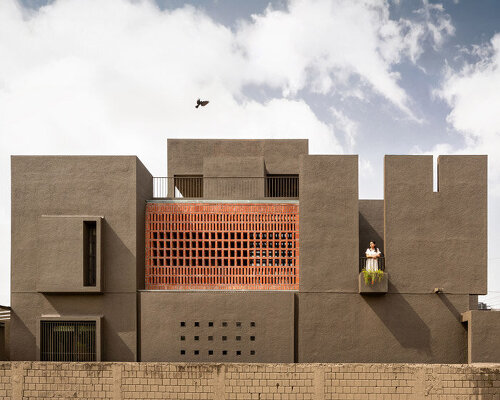lofty h-house rises in a narrow plot
The H-House by Studio Nirbaadh is a 2,850-square-foot residence located in Koregaon, a narrow urban pocket in Satara, India. Designed in response to the site’s elongated proportions, the brick and lime plaster home is organized along three parallel axes that structure the spatial layout and give the project its name.
This linear planning approach supports an intuitive and climate-conscious arrangement. The central axis anchors circulation, while the adjacent lines shape the structural and programmatic zones. The plan emphasizes flow — of people, light, and air — throughout the narrow plot.
images © Pranit Bora
studio birbaadh plans a central courtyard
One of the H-House’s defining spatial elements is a slender, semi-open courtyard that Studio Nirbaadh designs to run along the northern edge. This linear void operates as a transitional spine, at once encouraging cross ventilation, drawing daylight deep into the interior, and creating a tactile connection to the outdoors.
By aligning living spaces around this planted court, the architects create a continuous visual and environmental exchange. The courtyard serves daily functions as a space for informal gatherings and passive cooling, centering the house around a living landscape.
the H-House is located on a narrow site in Koregaon, Satara
a facade of brick screens
The west-facing facade directly addresses the challenges of heat and glare through a double-layered brick screen. Custom-designed for the project, the screen filters sunlight while maintaining privacy and reducing thermal load. It also casts changing patterns across the interiors, reinforcing the dialogue between structure and environment.
Additional facade elements, such as deep-set windows, blank masonry surfaces, and projecting planters, are employed to fine-tune the building’s thermal and visual performance. These architectural devices support a balance between openness and insulation, resulting in a structure that responds to its climate with deliberate restraint.
Studio Nirbaadh organizes the home around three parallel longitudinal axes
The house’s elevation reflects the tripartite planning strategy. Three dominant vertical walls rise in parallel, articulated with rhythmic windows, projecting planters, and brick detailing. These features reference the H-form in silhouette, giving the house a distinctive identity within its urban context. The form negotiates with its surroundings through materiality and proportion. The architecture relies on elemental expressions like brick, wood, and shaded voids to ground the building in its climate and community.
Inside, the H-House continues its minimal and tactile approach. A palette of exposed brick and wood joinery defines the interiors, where natural light is filtered and reflected to generate a soft, shifting ambiance. Furniture and built-in elements are pared back to reinforce a sense of visual clarity and openness.
a narrow courtyard along the northern edge brings light and ventilation into the interiors
the courtyard also functions as a social space and cooling spine within the linear plan
a perforated brick screen on the west-facing facade filters light and reduces solar gain
the facade includes deep-set windows and projecting planters for climatic control
vertical masonry walls echo the H-shaped layout in the home’s elevation
project info:
name: H-House
architect: Studio Nirbaadh
location: Koregaon, Satara, India
area: 2,850 square feet (265 square meters)
completion: 2025
photography: © Pranit Bora | Pranit Bora
lead architects: Dhanesh Gandhi, Tanushree Oswal
technical team: Nirag Parmar, Shekhar Kadam
lighting engineering, consulting: Anavi
electrical engineering, consulting: Legrand
The post studio nirbaadh’s H-house is a composition of layered walls and brick screens in india appeared first on designboom | architecture & design magazine.

